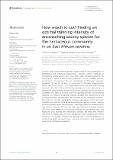| dc.description.abstract | Globally, bush encroachment poses a great threat to the conservation of biodiversity and rangeland productivity. However, control methods of encroaching woody species have rarely been experimentally quantified. We assessed the impact of tree thinning intensities on tree mortality, and the herbaceous community in Borana rangelands, an Ethiopian savannah ecosystem. At two 1.4 ha areas of mono-specific Vachellia drepanolobium stands, we set up 20 m x 10 m experimental plots with four tree-thinning treatments (0%, 33%, 67%, and 100% tree removal), with three replications in a randomized complete block design (RCBD) across two sites. The 0% plot was left uncleared and used as control. Over two growing periods, we monitored resulting tree mortality, coppicing, seedling mortality, and recruitment as well as herbaceous layer attributes (diversity, biomass) and the rangeland conditions. Tree thinning intensity significantly increased abundance of the dominant desirable grass species. Total herbaceous and grass species richness, diversity and biomass were significantly improved under high (100%) and moderate (67%) tree removal intensity. We conclude that tree thinning at moderate intensity (67%) was most effective in enhancing mortality of encroached trees, and improving grass diversity, and herbaceous biomass. We stress that effective tree thinning requires post-thinning management and repeated bush control measures. Our findings contribute to development of recommendations on controlling bush encroachment, species restoration, and rangeland productivity in Ethiopian rangelands. | en_US |

